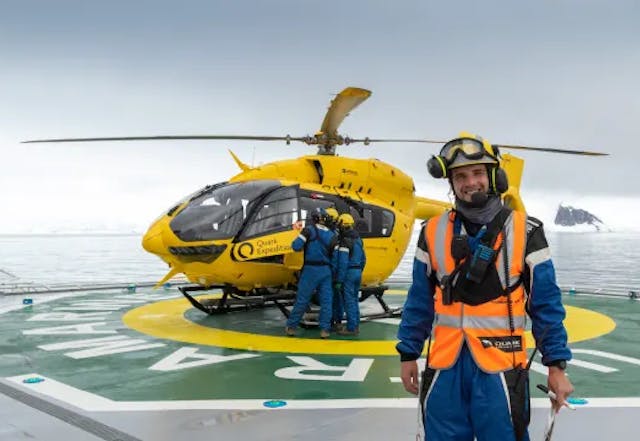Quark Expeditions Cruises
Explore the Ends of the Earth

- 3Specials
- 124Cruises
- 4ships
Quark Expeditions is a leading provider of polar adventure travel, offering immersive experiences to the Arctic and Antarctica. With a fleet of ice-strengthened ships, Quark Expeditions takes travelers to remote and breathtaking destinations, providing opportunities for wildlife encounters, hiking, kayaking, and more. Their expert expedition teams guide guests through these pristine landscapes, ensuring a safe and unforgettable adventure.
Quark Expeditions Cruises Overview Video
Quark Expeditions

Quark Expeditions Cruises Ship Classes
3 Classes of Ships, One Amazing Experience.
 UltramarineThe Ultramarine was built in 2021 and is designed for polar exploration, with a focus on active pursuits like kayaking and hiking.
UltramarineThe Ultramarine was built in 2021 and is designed for polar exploration, with a focus on active pursuits like kayaking and hiking.- Class Size:1 Ship
- Speed:Up to 16 Knots
- Total Guests:199 Guests
- Crew Size:140 Members
 World ExplorerThe Quark World Explorer is a modern expedition ship designed for comfort and exploration in the polar regions. Featuring spacious suites with private balconies, a glass-domed observation lounge, and a variety of dining and entertainment options, the World Explorer offers a luxurious and immersive experience. With its ice-class hull and advanced technology, this vessel is well-equipped to navigate the challenging conditions of the Arctic and Antarctic, providing guests with unforgettable opportunities to witness stunning landscapes and encounter incredible wildlife.
World ExplorerThe Quark World Explorer is a modern expedition ship designed for comfort and exploration in the polar regions. Featuring spacious suites with private balconies, a glass-domed observation lounge, and a variety of dining and entertainment options, the World Explorer offers a luxurious and immersive experience. With its ice-class hull and advanced technology, this vessel is well-equipped to navigate the challenging conditions of the Arctic and Antarctic, providing guests with unforgettable opportunities to witness stunning landscapes and encounter incredible wildlife.- Class Size:1 Ship
- Speed:Up to 16 Knots
- Total Guests:172 Guests
- Crew Size:130 Members
 Ocean ExplorerThe Ocean Explorer is a state-of-the-art polar expedition ship, designed to provide a luxurious and immersive experience in the Arctic and Antarctic. With its innovative X-Bow design, spacious cabins, and a wide range of amenities, the Ocean Explorer offers guests the opportunity to explore remote and breathtaking landscapes in comfort and style.
Ocean ExplorerThe Ocean Explorer is a state-of-the-art polar expedition ship, designed to provide a luxurious and immersive experience in the Arctic and Antarctic. With its innovative X-Bow design, spacious cabins, and a wide range of amenities, the Ocean Explorer offers guests the opportunity to explore remote and breathtaking landscapes in comfort and style.- Class Size:1 Ship
- Speed:Up to 16.5 Knots
- Total Guests:138 Guests
- Crew Size:105 Members
The Quark Expeditions Cruises Experience
Immeasurable added value to your perfect trip with Quark Expeditions

Immersive Experiences
Quark Expeditions offers a wide range of immersive experiences to enhance your polar adventure. From kayaking through pristine waters to hiking on glaciers and wildlife photography workshops, there's something for everyone. Expert guides and naturalists will accompany you on these excursions, sharing their knowledge and passion for the polar regions. These immersive experiences provide a truly unforgettable way to connect with the natural world and create lasting memories.

Helicopters
Quark Expeditions utilizes helicopters to provide guests with unique and exclusive access to remote and pristine locations in the Arctic and Antarctic. These helicopters allow passengers to land in areas inaccessible by ship, offering breathtaking aerial views and opportunities for up-close encounters with wildlife. By incorporating helicopters into their expeditions, Quark Expeditions provides guests with truly extraordinary and unforgettable experiences.
Frequently Asked Questions
Essential Information About Quark Expeditions Cruises
About Quark
On Board

Discover Your Perfect Quark Expedition
Search for your perfect trip or find it on the promo page